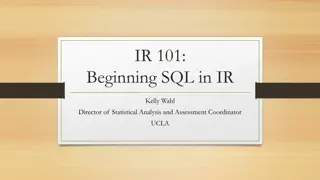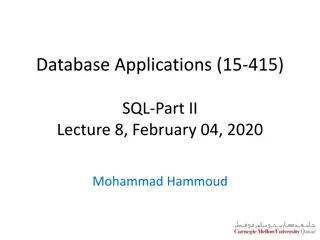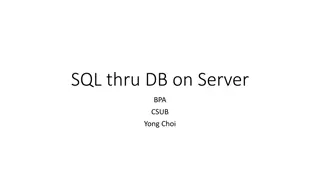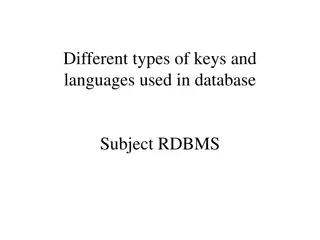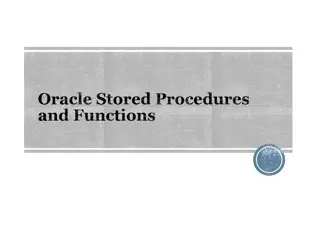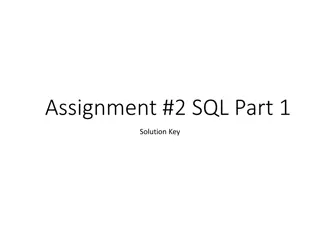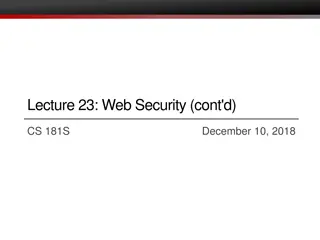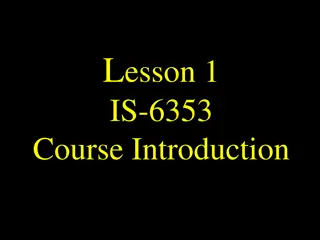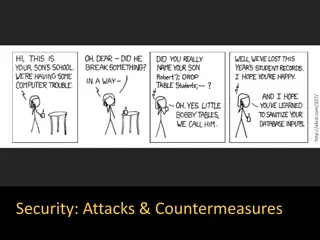Understanding Different Types of SQL Joins
Explore the various types of SQL joins such as INNER JOIN, LEFT (OUTER) JOIN, RIGHT (OUTER) JOIN, and FULL (OUTER) JOIN. Learn how each type functions and the syntax for implementing them. Get insights into examples of INNER JOIN and LEFT OUTER JOIN operations to enhance your SQL knowledge.
Download Presentation

Please find below an Image/Link to download the presentation.
The content on the website is provided AS IS for your information and personal use only. It may not be sold, licensed, or shared on other websites without obtaining consent from the author. Download presentation by click this link. If you encounter any issues during the download, it is possible that the publisher has removed the file from their server.
E N D
Presentation Transcript
SQL Joins Part 2
Types of Joins Inner Join NaturalJoin Left (Outer) Join Right (Outer) Join )Full)Outer Join Left (Outer) Join Excluding Inner Join Right (Outer) Join Excluding Inner Join (Full)Outer Join Excluding Inner Join CrossJoin
Different Types of SQL JOINs Here are the different types of the JOINs in SQL: (INNER) JOIN: Returns records that have matching values in both tables LEFT (OUTER) JOIN: Returns all records from the left table, and the matched records from the right table RIGHT (OUTER) JOIN: Returns all records from the right table, and the matched records from the left table FULL (OUTER) JOIN: Returns all records when there is a match in either left or right table
SampleTables TableA TableB PK Value PK Value 1 FOX 1 TROT 2 COP 2 CAR 3 TAXI 3 CAB 6 WASHINGTON 6 MONUMENT 7 DELL 7 PC 5 ARIZONA 8 MICROSOFT 4 LINCOLN 9 APPLE 10 LUCENT 11 SCOTCH
InnerJoin Inner join produces only the set of records that match in both Table A and Table B Most commonly used, best understood join Note: Inner Joins do not have to use equality to join the fields Can use <, >, <> INNER JOIN Syntax SELECT column_name(s) FROM table1 INNER JOIN table2 ON table1.column_name = table2.column_name;
InnerJoin TableA Value FOX COP TAXI WASHINGTON DELL TableB PK PK 1 2 3 6 7 Value TROT CAR CAB MONUMENT PC 1 2 3 6 7 SELECT * FROM TableA INNERJOIN TableB ON TableA.PK = TableB.PK; This is the same as doing SELECT * FROM TableA, TableB WHERE TableA.PK = TableB.PK;
InnerJoin(continued) TableA PK TableB PK SELECT * FROM TableA INNER JOIN TableB ON TableA.PK > TableB.PK; Value Value 2 COP 1 TROT 3 TAXI 1 TROT 3 TAXI 2 CAR 4 LINCOLN 1 TROT 4 LINCOLN 2 CAR 4 LINCOLN 3 CAB 5 ARIZONA 1 TROT 5 ARIZONA 2 CAR 5 ARIZONA 3 CAB More Rows
LeftOuterJoin Left outer join produces a complete set of records from Table A, with the matching records (where available) in Table B. If there is no match, the right side will contain null.
LeftOuterJoin TableA Value FOX COP TAXI LINCOLN ARIZONA WASHINGTON DELL LUCENT TableB PK PK 1 2 3 4 5 6 7 10 Value TROT CAR CAB NULL NULL MONUMENT PC NULL 1 2 3 NULL NULL 6 7 NULL SELECT * FROM TableA LEFT OUTER JOIN TableB ON TableA.PK = TableB.PK
SQL JoinsExample SELECT S.name, E.classid FROM Students S LEFT OUTER JOIN Enrolled E ON S.sid=E.sid E.sid E.classid S E S.name S.sid 11111 History105 Jones 11111 11111 DataScience194 Smith 22222 22222 French150 Brown 33333 44444 English10 S.name E.classid Jones History105 Jones DataScience194 Smith French150 Brown NULL
RightOuterJoin Right outer join produces a complete set of records from Table B, with the matching records (where available) in Table A. If there is no match, the left side will contain null.
Note: RIGHT are not currently supported RightOuterJoin TableA Value FOX COP TAXI WASHINGTON DELL NULL NULL NULL TableB PK PK 1 2 3 6 7 NULL NULL NULL Value TROT CAR CAB MONUMENT PC MICROSOFT APPLE SCOTCH 1 2 3 6 7 8 9 11 SELECT * FROM TableA RIGHT OUTER JOIN TableB ON TableA.PK = TableB.PK
SQL Joins..example SELECT S.name, E.classid FROM Students S RIGHT OUTER JOIN Enrolled E ON S.sid=E.sid E.sid E.classid S E S.name S.sid 11111 History105 Jones 11111 11111 DataScience194 Smith 22222 22222 French150 Brown 33333 44444 English10 S.name E.classid Jones History105 Jones DataScience194 Smith French150 NULL English10
FullOuterJoin Full outer join produces the set of all records in Table A and Table B, with matching records from both sides where available. If there is no match, the missing side will contain null.
FullOuterJoin TableA Value TableB PK PK Value FOX 1 1 TROT COP 2 2 CAR TAXI 3 3 CAB LINCOLN 4 NULL NULL ARIZONA 5 NULL NULL WASHINGTON 6 6 MONUMENT DELL 7 7 PC LUCENT 10 NULL NULL NULL NULL 8 MICROSOFT NULL NULL 9 APPLE NULL NULL 11 SCOTCH SELECT * FROM TableA FULL OUTER JOIN TableBON TableA.PK = TableB.PK
SQL Joins.. Example SELECT S.name, E.classid FROM Students S FULL OUTER JOIN Enrolled E ON S.sid=E.sid E.sid E.classid S E S.name S.sid 11111 History105 Jones 11111 11111 DataScience194 Smith 22222 22222 French150 Brown 33333 44444 English10 S.name E.classid Jones History105 Jones DataScience194 Smith French150 NULL English10 Brown NULL
CrossJoin A cross join is a Cartesian Product join it is every record in TableA combined with every record in Table B. It gives the same results as not using a WHERE clause when querying two tables in MySQL SELECT * from TableA CROSS JOIN TableB SELECT * from TableA, TableB
SQL Joins SELECT * FROM Students S CROSS JOIN Enrolled E S E E.sid E.classid S.name S.sid 11111 History105 Jones 11111 11111 DataScience194 Smith 22222 22222 French150 S.name S.sid E.sid E.classid Jones 11111 11111 History105 Jones 11111 11111 DataScience194 Jones 11111 22222 French150 Smith 22222 11111 History105 Smith 22222 11111 DataScience194 Smith 22222 22222 French150
Theta Joins SELECT * FROM Students S, Enrolled E WHERE S.sid <= E.sid E S E.sid E.classid S.name S.sid 11111 History105 Jones 11111 11111 DataScience194 Smith 22222 22222 French150 S.name S.sid E.sid E.classid Jones 11111 11111 History105 Jones 11111 11111 DataScience194 Jones 11111 22222 French150 Smith 22222 22222 French150
LeftJoinExcludingInnerJoin This query will return all of the records in the left table (table A) that do not match any records in the right table (table B).
LeftJoinExcludingInnerJoin TableA Value TableB PK PK Value LINCOLN 4 NULL NULL ARIZONA 5 NULL NULL LUCENT 10 NULL NULL SELECT * FROM TableA LEFT JOIN TableB ON TableA.PK = TableB.PK WHERE TableB.PK IS NULL; Perform left outer join, then exclude the records we don't want from the right side via a where clause.
RightJoinExcludingInnerJoin This query will return all of the records in the right table (table B) that do not match any records in the left table (table A).
RightJoinExcludingInnerJoin TableA Value TableB PK PK Value NULL NULL 8 MICROSOFT NULL NULL 9 APPLE NULL NULL 11 SCOTCH SELECT * FROM TableA RIGHT JOIN TableB ON TableA.PK = TableB.PK WHERE TableA.PK IS NULL Perform right outer join, then exclude the records we don't want from the left side via a where clause.
FullOuterExcludingInnerJoin This query will return all of the records in Table A and Table B that do not have a matching record in the other table. In general, Not used
FullOuterExcludingInnerJoin TableA Value TableB PK PK Value NULL NULL 8 MICROSOFT NULL NULL 9 APPLE NULL NULL 11 SCOTCH LINCOLN 4 NULL NULL ARIZONA 5 NULL NULL LUCENT 10 NULL NULL SELECT * FROM TableA FULL OUTER JOIN TableB ON TableA.PK = TableB.PK WHERE TableA.PK IS NULL OR TableB.PK IS NULL



